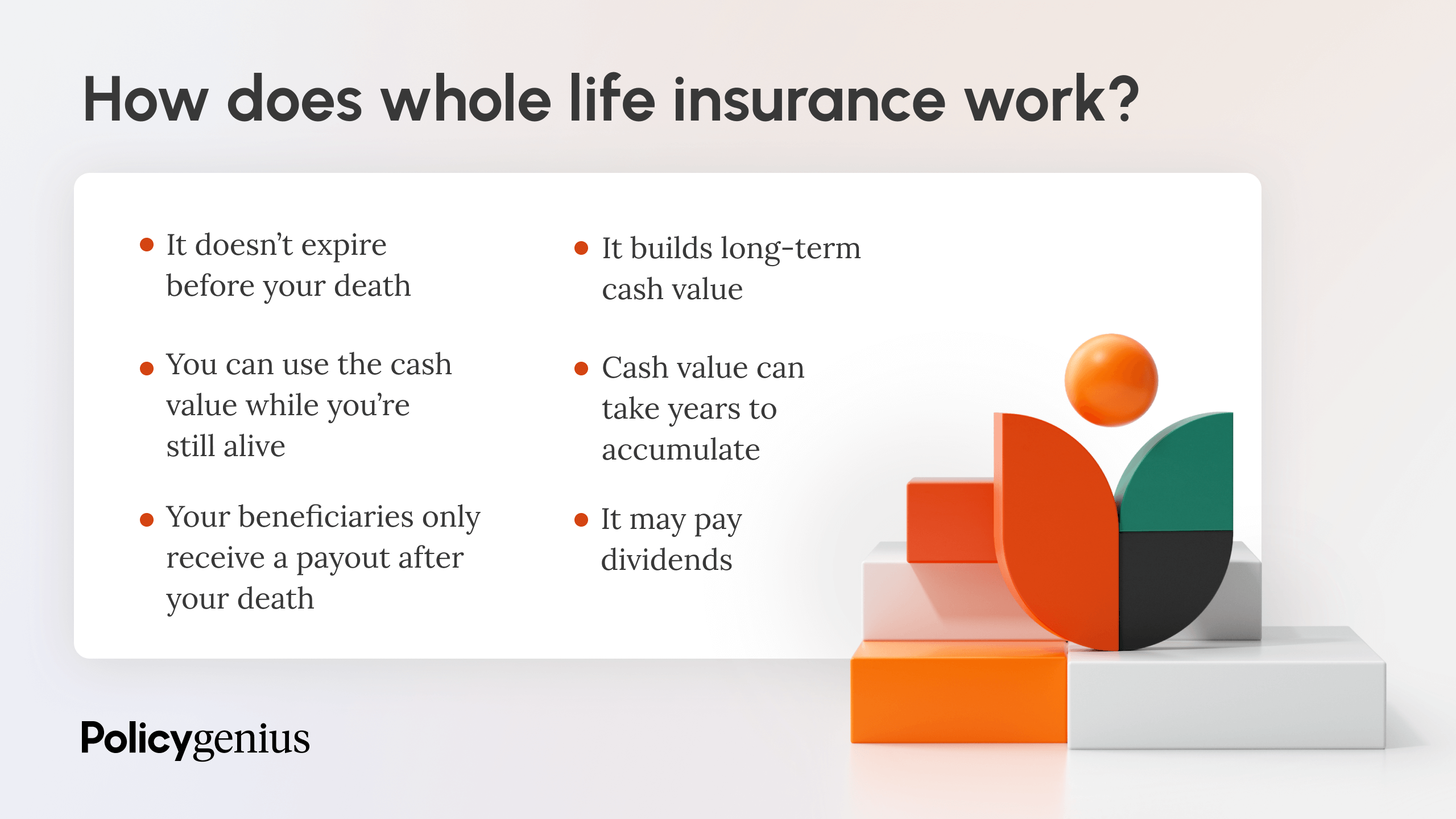Whole Life Insurance Simplified: A Guide to Lifelong Security
Whole life insurance guarantees payment of a death benefit to beneficiaries in exchange for level, regularly-due premium payments. The policy includes a savings portion, called the “cash value,” alongside the death benefit.
Whole life insurance provides lifelong coverage and a savings component that grows over time. It offers a guaranteed death benefit, fixed premiums, and a cash value that accumulates tax-deferred. This type of insurance can serve as a valuable component of a comprehensive financial plan, providing protection and potential for cash accumulation.
When considering whole life insurance, it's important to weigh the benefits and drawbacks to determine if it aligns with your long-term financial goals. Understanding the features and implications of whole life insurance can help individuals make informed decisions about their insurance needs.
:max_bytes(150000):strip_icc()/dotdash-term-life-vs-whole-life-5075430-Final-60fb4e8f7bae43e0a65a3fac2431479c.jpg)
Credit: www.investopedia.com
Introduction To Whole Life Insurance
Whole Life Insurance provides a guaranteed death benefit to beneficiaries in exchange for consistent premium payments. This policy includes a cash value component, offering both protection and a savings feature for the insured. Whole life insurance ensures coverage for the duration of one's life.
| Whole Life Insurance: A policy guaranteeing a death benefit to beneficiaries in exchange for premium payments. |
| Key Features: Includes a cash value component in addition to the death benefit. |
| Disadvantages: More complex than term life insurance, higher premiums, costly if coverage lapses early. |

Credit: unitedbenefits.com
Benefits Of Whole Life Insurance
Whole Life Insurance offers lifelong coverage and a cash value component, ensuring a guaranteed death benefit for beneficiaries. Unlike term life insurance, whole life policies have level premiums and provide financial security throughout one's lifetime. Protect your family's future with this comprehensive coverage option.
| Whole Life Insurance |
| Benefits of Whole Life Insurance |
| Lifetime Coverage: Whole life insurance provides coverage for the entire life of the insured, offering peace of mind and financial security for loved ones. |
| Cash Value Benefits: This policy accumulates cash value over time, which can be borrowed against or withdrawn to supplement retirement income. |
| Fixed Premiums: With whole life insurance, the premiums remain constant throughout the policy’s duration, providing financial stability and predictability. |
Understanding Premiums
Whole life insurance guarantees payment of a death benefit to beneficiaries in exchange for level, regularly-due premium payments. The policy includes a savings portion, called the “cash value,” alongside the death benefit. When considering cost factors for premiums, it's important to note that whole life insurance tends to have higher premiums compared to term life insurance. Additionally, comparing premiums with other insurance types, such as term life insurance or universal life insurance, can help in understanding the relative costs and benefits of whole life insurance. It's crucial to carefully assess individual financial needs and long-term goals before choosing a life insurance policy.

Credit: www.policygenius.com
Cash Value Explained
Whole life insurance includes a savings component known as the "cash value," in addition to the death benefit. This type of policy guarantees a payout to beneficiaries in exchange for regular premium payments. It offers lifelong coverage and the potential for the cash value to grow over time, providing a valuable financial asset.
| Cash Value Explained |
| How Cash Value Accumulates |
| Whole life insurance policies include a savings portion called the "cash value." This cash value accumulates over time as the policyholder continues to pay their level premiums. A portion of each premium payment goes towards the cash value, which earns interest at a fixed rate set by the insurance company. As the cash value grows, the policyholder may be able to borrow against it or withdraw funds. However, any outstanding loans or withdrawals will reduce the death benefit payable to beneficiaries. It's important to note that borrowing against the cash value will also incur interest charges and may affect the policy's long-term growth. Policyholders should consult with their insurance agent or financial advisor before making any decisions regarding their policy's cash value. |
| Using Cash Value for Loans or Withdrawals |
| Policyholders can use the cash value of their whole life insurance policy to take out a loan or make a withdrawal. Loans must be repaid with interest, which is usually set at a fixed rate by the insurance company. If the policyholder chooses to make a withdrawal, they will receive a portion of the policy's cash value, but this will reduce the policy's death benefit. It's important to note that any outstanding loans or withdrawals will reduce the death benefit payable to beneficiaries. It's also important to consider the long-term impact of borrowing against the policy's cash value and to consult with a financial advisor before making any decisions. |
Pros And Cons Of Whole Life Insurance
Whole life insurance provides a guaranteed death benefit and a cash value component, but it comes with higher premiums and is more complex than term life insurance. While it offers lifelong coverage, it could be costly if the coverage lapses early.
| Advantages Over Term Life Insurance | Potential Drawbacks |
|---|---|
| Guarantees payment of death benefit to beneficiaries | More complex than term life insurance |
| Includes savings portion called "cash value" | Higher premiums than term life insurance |
| Can be used as an investment tool | Could be costly if coverage lapses early |
Choosing The Right Policy
Whole life insurance guarantees payment of a death benefit to beneficiaries in exchange for level, regularly-due premium payments. The policy includes a savings portion, called the “cash value,” alongside the death benefit. Whole life insurance is a permanent life plan that provides coverage throughout your entire life. The premiums tend to cost more than a term plan would, but it offers lifelong protection and a cash value component that can grow over time.
Whole Life Insurance For Different Life Stages
Whole Life Insurance is a versatile option that adapts to different life stages. It offers a guaranteed death benefit and a cash value component, providing security and savings for the long term. Whether you're starting a family or planning for retirement, Whole Life Insurance can offer protection and financial stability throughout your life journey.
| Whole Life Insurance guarantees payment of a death benefit to beneficiaries in exchange for level, regularly-due premium payments. The policy includes a savings portion, called the “cash value,” alongside the death benefit. |
| Benefits in Youth: Whole life insurance can provide financial security and peace of mind for young individuals. It offers fixed premiums and cash value accumulation that can be utilized in the future. |
| Advantages in Middle Age: As individuals progress into middle age, whole life insurance can serve as a long-term investment with guaranteed returns and protection for loved ones. |
| Considerations for Seniors: For seniors, whole life insurance provides financial legacy and final expense coverage, ensuring financial stability for their families. |
Real-life Examples And Case Studies
Real-life examples and case studies showcase how whole life insurance provides a guaranteed death benefit and a cash value savings component. These policies offer long-term financial protection for beneficiaries and policyholders. Whole life insurance stands out for its level premiums and lifelong coverage.
| Whole life insurance guarantees payment of a death benefit to beneficiaries in exchange for level, regularly-due premium payments. The policy includes a savings portion, called the “cash value,” alongside the death benefit. Whole life insurance is a permanent life plan that provides coverage throughout your entire life. The premiums tend to cost more than a term plan would. A more complex product than term life insurance, it has higher premiums and could be costly if coverage lapses early. |
Frequently Asked Questions
How Much Does A $100,000 Whole Life Insurance Policy Cost?
A $100,000 whole life insurance policy typically costs between $100 to $200 per month.
What Does A Whole Life Insurance Policy Cover?
A whole life insurance policy covers a guaranteed death benefit for beneficiaries in exchange for regular premium payments. It also includes a cash value savings component.
What Are Two Disadvantages Of Whole Life Insurance?
The two disadvantages of whole life insurance are higher premiums compared to term life insurance and the potential for it to be costly if coverage lapses early.
How Much Does $500,000 Whole Life Insurance Cost?
The cost of $500,000 whole life insurance varies based on the age, health, and lifestyle of the individual. However, on average, the monthly premium can range from $500 to $1,000. It's recommended to get quotes from multiple insurance providers to compare rates and coverage options.
Conclusion
Whole life insurance provides lifelong coverage with a death benefit and cash value. It's a long-term financial tool for security and protection. Consider the pros and cons before choosing a policy that suits your needs and goals. Make an informed decision for your future.




